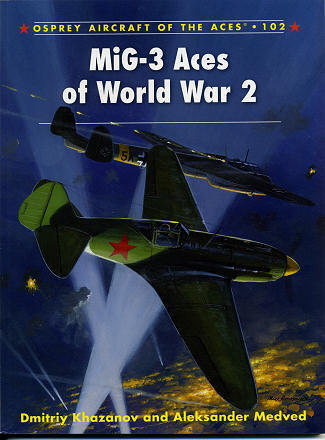 The MiG-3
was an aircraft designed for a mission that was rarely realized. The sleek
airframe was attached to the most powerful in-line engine that Soviet industry
was able to produce. This gave the aircraft a very high rate of climb, for its
intended purpose was to claw its way into the skies in search of high altitude
enemy bombers. This required an airframe more designed for performance at high
altitude than at low level and its engine was so designed to meet this
requirement. The result was a very good high altitude interceptor.
The MiG-3
was an aircraft designed for a mission that was rarely realized. The sleek
airframe was attached to the most powerful in-line engine that Soviet industry
was able to produce. This gave the aircraft a very high rate of climb, for its
intended purpose was to claw its way into the skies in search of high altitude
enemy bombers. This required an airframe more designed for performance at high
altitude than at low level and its engine was so designed to meet this
requirement. The result was a very good high altitude interceptor.
Unfortunately for the Soviets, not all that many enemy
planes flew at high altitudes. Not only that, but the MiG-3 was not exactly an
aircraft where one could just hop in and fly it. It required a goodly amount of
training to be able to fly safely. It did not help that the aircraft was plagued
with the usual teething problems that all new planes run into. Add on to it some
questionable quality control and you had a plane that many of the uniformed and
untrained called a dangerous plane.
However, a well trained and skillful pilot was able to
take the MiG-3s advantage of vertical speed and a good zoom capability to be
successful in the aircraft. It was also quite useful in reaching German
reconnaissance aircraft, which usually flew at a relatively high altitude. While
not envisioned as a night fighter, the plane had some success in this mission.
It was also an aircraft that was available in the first year or so when quantity
was much more important than quality and it was important to have planes to meet
the German onslaught.
On all fronts, the MiG-3 units fought with much bravery,
overclaiming successes, just like other air forces. The MiG-3 was also plagued
by a lack of spare parts and thanks to an engine that was not really good for a
lot of hours, the ratio of in service to out of service planes was low, with
units frequently having no operational aircraft to fly.
Still, it soldiered on and while mostly replaced by late
1943 in the west, was flown in eastern Russia until near the end of the war.
In this book by Robert Forsyth, we take a look at the
growing development of the aircraft as well as the tactics used by the pilots.
Each of the various areas of operation from the far north to the Crimea are
covered in separate sections. These are filled with the great stories from
pilots that make this series so interesting. This includes tales of ramming
enemy bombers once the ammunition was expended. The MiG-3 was not heavily armed.
As with all books in this series, it is superbly
illustrated not only with period photos of the men and planes, but also with
several pages of full color profiles. It makes for an excellent read for
enthusiasts and a great reference for modelers.
February 2012
For more on the complete line of Osprey books,
visit www.ospreypublishing.com. In the US, it is
Osprey Direct at 44-02 23rd St, Suite 219, Long Island City, NY 11101., where you can
get a catalogue of available books.
If you would like your product reviewed fairly and quickly, please
contact
me or see other details in the
Note to
Contributors.
 The MiG-3
was an aircraft designed for a mission that was rarely realized. The sleek
airframe was attached to the most powerful in-line engine that Soviet industry
was able to produce. This gave the aircraft a very high rate of climb, for its
intended purpose was to claw its way into the skies in search of high altitude
enemy bombers. This required an airframe more designed for performance at high
altitude than at low level and its engine was so designed to meet this
requirement. The result was a very good high altitude interceptor.
The MiG-3
was an aircraft designed for a mission that was rarely realized. The sleek
airframe was attached to the most powerful in-line engine that Soviet industry
was able to produce. This gave the aircraft a very high rate of climb, for its
intended purpose was to claw its way into the skies in search of high altitude
enemy bombers. This required an airframe more designed for performance at high
altitude than at low level and its engine was so designed to meet this
requirement. The result was a very good high altitude interceptor.